#Photography vs Technology
Explore tagged Tumblr posts
Text
Photography Capturing Time
Photography has always felt like a little slice of magic to me. I first encountered it more seriously when I studied media in college, and I was instantly hooked. There’s something so powerful about freezing a moment in time, capturing it in a frame, and preserving it forever.
The act of taking a photograph felt like an art form all its own whether it was the vibrant colours of a sunset over the horizon or the minute details in the veins of a leaf under the lens of macro photography.
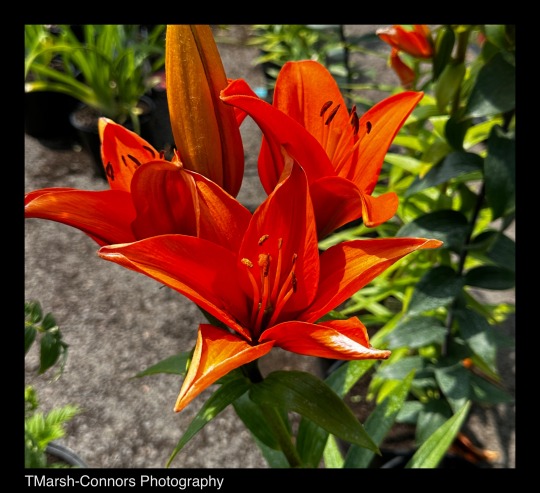
While I was in college, I immersed myself in different techniques and styles. But my heart was often drawn to landscapes and macro shots. The vastness of a wide open sky or the intricate beauty in something as small as a dewdrop on a blade of grass it’s these details that speak to the essence of photography. It’s about taking something fleeting and making it permanent, giving it a story and a life beyond the present moment.

But here’s where my love for photography faces a bit of a dilemma in modern times: the advancement of phone cameras. Don’t get me wrong there’s something to admire about the capabilities of the new iPhone 16 Pro, for instance. Its ability to capture professional-grade photos with just the tap of a button is impressive, but I can’t help but feel like it takes some of the work, and even the soul, out of photography. In the past, you had to think more deeply about the process of focusing the lens just right, balancing light and shadow, and choosing the right angle to capture the perfect shot.
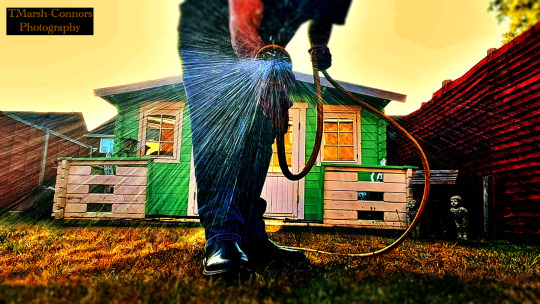
With modern smartphones, much of that thought process is automated. Sure, the convenience is there, but the art of photography seems to get lost in the race for the most advanced technology. It’s not just about snapping a picture but being part of the scene, composing it with intent and care.
At the end of the day, photography is about more than the gear you use. It’s the feeling you get when you frame that perfect shot the sense that you’ve captured a moment that might otherwise be lost to time. And no matter how advanced technology gets, that magical feeling will never go away.

One more thing. I adore black-and-white photography too.
#Photography#Media Studies#College Photography#Landscape Photography#Macro Photography#Capturing Time#Freezing Moments#iPhone Photography#iPhone 16 Camera#Photography Technology#Modern Photography#Smartphone Photography#Creative Photography#Photography Techniques#Photography Passion#Photography vs Technology#Photo Composition#Photography Art#Nature Photography#Digital Photography
1 note
·
View note
Text

Moninga░vibes░in░a░moninga░night (ケ羽ホイ行マ)
#modena#purple#retro#violet#aesthetic#vaporwave#photography#design#technology#blue aesthetic#red vs blue#italia#trance
30 notes
·
View notes
Text
Balancing Tradition and Innovation: Lessons from a Changing Workplace
A Tale of Two Eras.Technology has reshaped nearly every aspect of modern work, but its impact hasn’t been uniform across industries. I’ve had the unique experience of working in roles that were transformed almost overnight by technology, while others remained relatively untouched. And then there’s photography—where the evolution has been profound, yet the essence of the craft feels…
#adapting to change#balancing tradition and innovation#dailyprompt#dailyprompt-1889#digital vs. analog#maintaining core skills#photography evolution#professional growth#remote work impact#technology in work
0 notes
Text
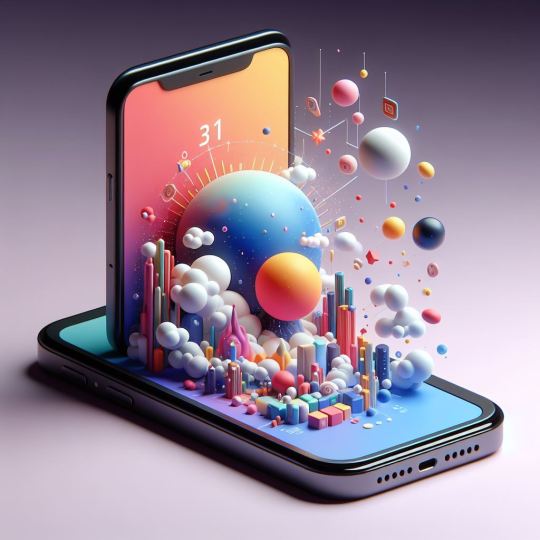
Unleash the Power of Samsung M31s: Ultimate Review!
Welcome to our in-depth review of the Samsung M31s! In this video, we delve into every aspect of this incredible smartphone, exploring its features, performance, and capabilities. Whether you're a tech enthusiast or a casual user, this review is your ultimate guide to understanding the Samsung M31s. Join us as we uncover its strengths, weaknesses, and everything in between. Get ready to unleash the power of Samsung M31s!
Know more
#samsung m31s review#samsung m31s features#samsung m31s performance#samsung m31s camera#samsung m31s specifications#samsung m31s comparison#samsung m31s vs iphone#samsung m31s vs competitors#samsung galaxy m31s#best budget smartphones#smartphone buying guide#tech reviews#mobile gaming#samsung tips and tricks#smartphone photography#samsung accessories#samsung apps#mobile device management#android smartphones#samsung innovations#mobile technology trends#samsung product showcase#smartphone customization#samsung ecosystem#mobile productivity#samsung software updates#samsung user experience#smartphone durability#samsung warranty#smartphone storage solutions
1 note
·
View note
Text
Hard & Soft: An Explanation of Light
I was watching a video from one of my favorite tech YouTubers, Mr. Whose the Boss. He was showing off some of his favorite tech and pulled out this tiny LED light.

And then he placed a diffuser on the front and said this...

"You can equip a softbox on the front which *massively* softens the light on your face."
Sorry, Arun.
No it doesn't.
I sometimes wish I could get a job as a YouTube lighting advisor. So many creators have to set up and use professional lighting but very few actually have an understanding of how their lighting works. And with just a little knowledge they could up their lighting game big time.
If nothing else, I could stop the plague of ring lights.
Ring lights are my nemesis.
*shakes fist at ring lights*
Arun repeated a classic myth. Diffusing a light does *not* make it softer. And despite the name, a softbox is fully capable of producing hard light. Especially if it is only the size of your granddad's wallet.
I'm afraid softboxes are a bit misnamed—much like how the tremolo system on a guitar is technically a vibrato mechanism. Tremolo is a fluctuation of volume, not pitch. Personally, I just stick to calling it a whammy bar because that is more fun anyway. And, like, what does "whammy" even mean in the context of a guitar? I'd rather call something by a nonsensical name than an inaccurate one, ya know?
What the hell was I saying?
SOFTBOXES!
They should probably be called "light homogenizers." Which is a mouthful, but more accurate.
Or, hear me out... WHAMMY BOXES.
Froggie Note: I am trying a color coding technique to help make the most important information stand out. Red means PAY ATTENTION and blue means "do your best to remember this." Let me know if this is helpful or annoying or if a different color combo is preferred.
Hard Light vs. Soft Light
Hard light is a less flattering light source that creates high contrast, sharp shadows, and accentuates texture.
Soft light is a more flattering light source that creates soft shadows and reduces texture like pores, blemishes, and wrinkles.
You can *only* get hard or soft light by changing the apparent size of a light source from the subject's point of view.
If you remember only three things about light, they should be...
Bright light = sharp photos, less noise Hard light = small light source Soft light = large light source
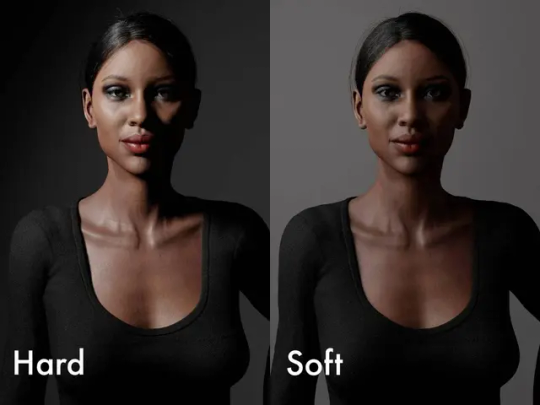
Now, it's important to remember that hard light is not *bad* and soft light is not *good*. In photography, the oft-used parlance "flattering" just refers to the rendering of facial features and blemishes. So you might use a more flattering lens to make sure faces do not distort or a more flattering light modifier to reduce wrinkles.
But there are situations where soft light can be very boring and hard light can be much more dynamic and interesting. But if you have someone who is insecure about their skin or has a lot of blemishes, you can mitigate that by making the light softer. But if you have someone with great skin and a lot of angular facial features, you might use a hard light to show that off.
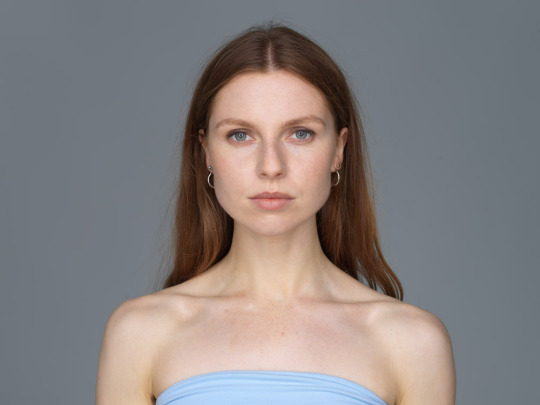
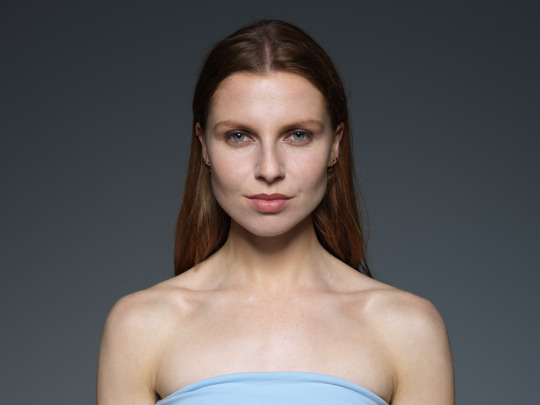
Which of these do you prefer?
The one on the left was taken with a 7 foot diameter light source and is *very* soft. But the other had a 1 foot diameter and I think it is more dynamic and interesting.
You can also mix hard and soft light. And with something like a parabolic reflector or a beauty dish, you can even modify a light source to be hard and soft at the same time.

This technological terror of a light modifier is sort of like having 24 individual small lights around the edges but the entire surface of the reflector also acts as a single large light source.
And when it isn't atomizing Alderaan, it is taking photos like this...
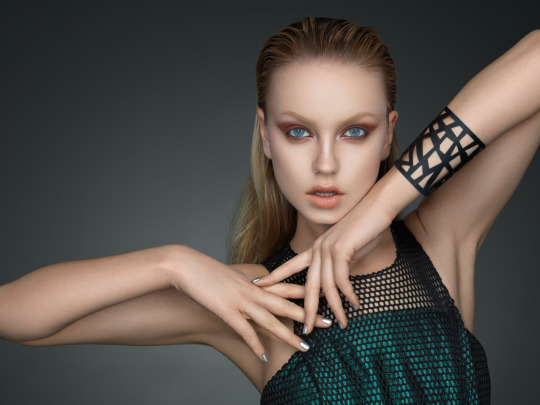
This creates a falloff of light around the edges of her face, nose, and arms while also reducing the intensity of the shadows. Lenses with longer focal lengths prevent distortion of facial features but also flatten our faces. So a modifier like this can bring back dimensionality.
Neat!
Now I just need $8,000 to buy the Death Star light.
There are a ton of possibilities when it comes to modifying light sources, but most people typically want the main light on the subject to be in the realm of soft and use hard light sources as edge lights.
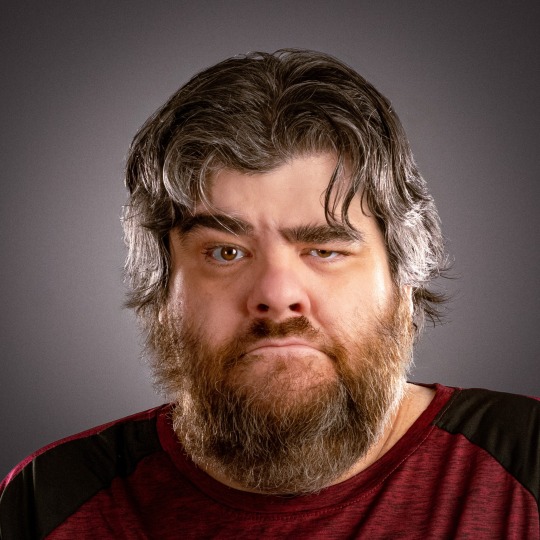
Also, everything is a spectrum and light is no different. There is a giant space in between hard and soft to play with. In fact, the hardest light possible would be cast on a subject floating in space.
And the softest light possible would be on a planet that has 100% cloud coverage that still allows sunlight to scatter through.
So, I have determined the surface of Venus to be the most flattering light in the universe.
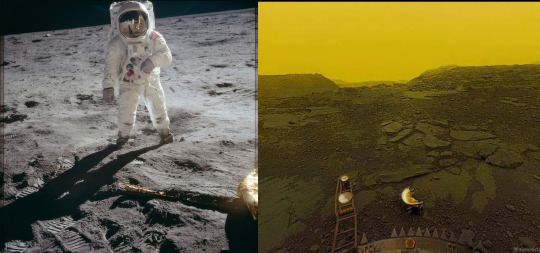
Look at how dark and sharp that astronaut shadow is! And I'm sure Venusian photography would be quite popular if you wouldn't burst into flames.
On planet Earth, noon on a clear day would be the hardest light and a very overcast day would be the softest light.

How can the sun be both hard and soft light?
Well, the sun is quite large, but it is very small in the sky and very far away. It is the only thing humans can observe that is close to a "point" light source—the smallest light source possible that shines light equally in all directions.
But on an overcast day, sunlight scatters through all of the clouds and becomes a HUGE homogenous light source. The clouds become a singular giant light above us. And as you can see, the light is so soft the woman does not have a hint of shadow on her face. And shadows can draw attention to pores, wrinkles, blemishes, and other textures.
But wouldn't the smallest light source be a laser or something?
When photographers refer to a small light source we mean from the perspective of the subject being lit. This is referred to as apparent or angular size.
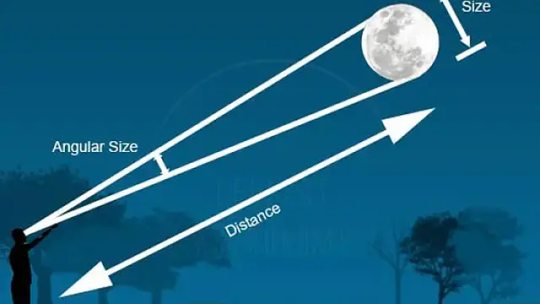
But you also have to account for the size of the area the light source can illuminate.
This is the area a laser can light up.
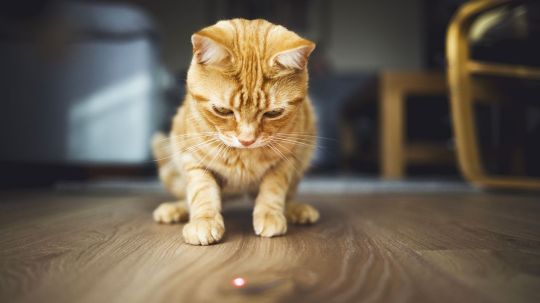
And this is the area the sun is able to cats cast light upon.
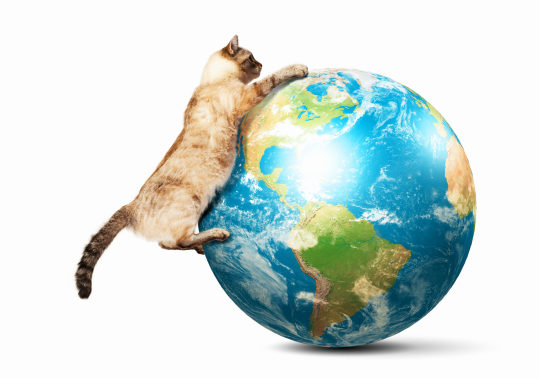
It doesn't matter if a laser is close or far away, it focuses light onto a very small area. But the sun lights up half the planet. So look at imagine the apparent size of the sun in the sky and compare its size to half of the Earth. In that relative circumstance, the sun is a super tiny light source.
And the sun becomes an even tinier light source on the moon because there is no atmosphere or clouds to scatter and enlarge it.
You can change the apparent size of a light source in two ways...
The physical dimensions of the light and the distance from the subject.
A light with small dimensions can be a large light source if it is close enough and if the subject is small enough. So a flashlight could be a large light source for an ant if that flashlight is directly next to said ant. But a flashlight could never be a large light source to a human.
However, we can enlarge small light sources with modifiers.
A modifier can be a softbox. It can be a piece of paper. A large poster board. A wall or a ceiling. Anything that changes the nature of a light source can be a modifier. But not all modifiers increase the size of a light source.
So, you can take that flashlight, shine it on a wall, and reflect the light to make a giant light source capable of producing softer light.
But what you cannot do is put diffusion material directly in front of a flashlight and make the light it produces softer.
When Arun put that diffuser on the front of that tiny light, he was not making the light any bigger. He was only making the light more diffused.
What does diffusion *actually* do?
Diffusion scatters light. It makes light bounce in all directions and keeps it from being focused. And while this is an important aspect to making a light source larger, it does not change the apparent size of a light source on its own.
Diffused light is homogenous.
A homogenous light source has the same intensity across its entire surface area. And that homogenization is the key to creating a better soft light source. It can *assist* in making a light source larger, but only if you know how to wield that diffusion properly.
When you shine a flashlight toward a wall, you increase the apparent size of the light source.
Fantastic! You now have a softer light. Mission accomplished.
But if you do not diffuse it, you will create a hotspot.

That bright hotspot will reflect more light than all of the other light reflecting off the wall. That reflected light has different intensities across its surface area and you end up creating TWO distinct light sources—one hard and one soft.

This can sometimes be desired if you want to create graduated light that falls off like I showed earlier. But if it is not controlled well with a specialized modifier a hotspot can cause more problems than benefits.
This can reveal unwanted texture, double shadows, cause harsh glare, and it may not achieve the desired amount of soft, flattering light you were hoping for.
However, if you diffuse the light from the flashlight before it hits the wall, the light will scatter and reflect off the wall more evenly. You will create a more *homogenous* light source that acts as a single entity of light.
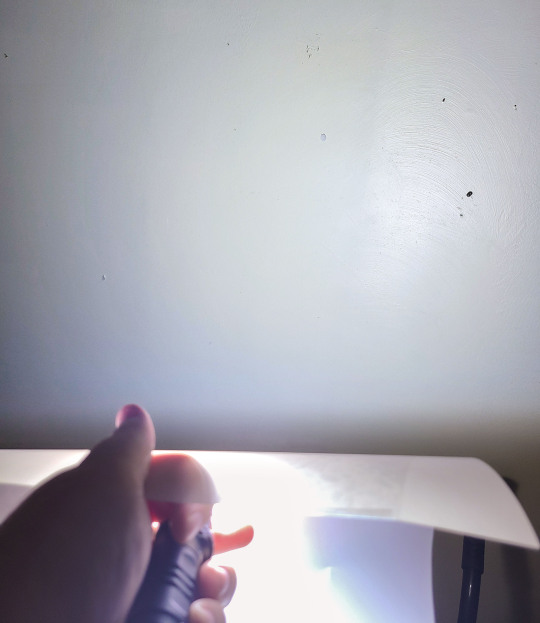
Diffusion does reduce the overall intensity of the light, but that is usually a worthy trade off for the increased homogeny.
These pesky hotspots are actually a big problem with those cheap softboxes you can buy off Amazon.

Many of them do not have enough diffusion to create a single homogenous light source. So they end up with a hotspot that gives you that double light source effect.
I was able to fix this with my friend Katrina's softbox by adding a layer of tracing paper in front.
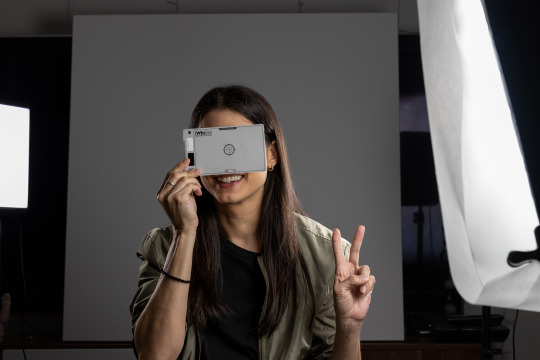
You can see the chip clip holding the tracing paper in place on the right side.
Photography is just problem solving all the way down.
A higher quality softbox will have a second layer of diffusion already built in to prevent this, so make sure the softbox has this feature before buying.
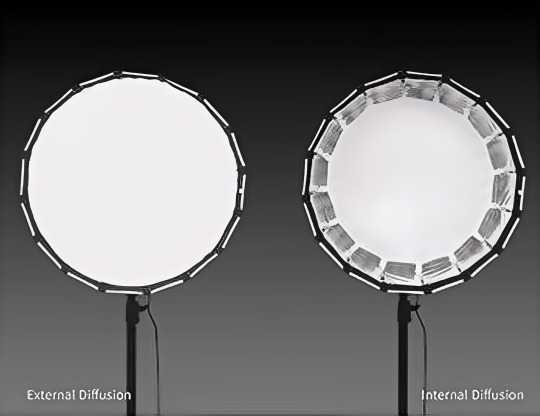
Or invest in a roll of tracing paper and some chip clips.
Softboxes are an ingenious light modifier when built properly. They take a small light, diffuse it, enlarge it, and then focus it toward your subject. It's essentially a paradox of scattered & focused light. And since all of the scattering only happens *inside* the softbox, it gives you great control over how that light hits your subject. And you can focus it even more by putting a grid on the front.
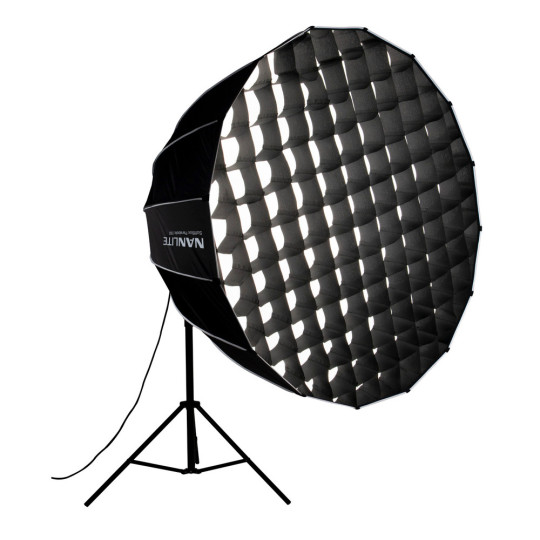
This keeps light from "spilling" off to the sides though it can reduce intensity a bit and create unusual looking catchlights in the eyes.
Whereas a cheap shoot-through umbrella kinda "shoots" scattered light all over the place and causes a ton of extra reflections off the walls and ceilings. That may end up giving you unwanted second, third, and fourth light sources contributing to your exposure.
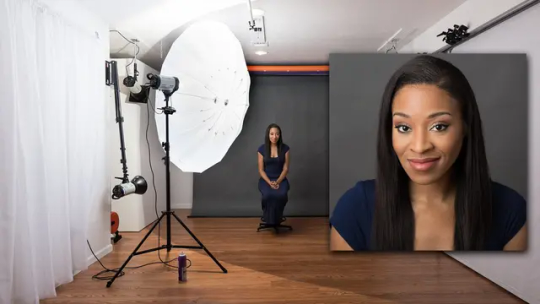
You can see light hitting the left and right walls and the ceiling—those pesky photons are going everywhere! And while it is giving a soft, flattering result due to that umbrella being so freaking big, you have almost no control over the light and how it affects your background.
So, yes, a softbox can make a small light source bigger, but that doesn't always mean you will get "soft" light.
This softbox takes a 10 inch LED panel and creates a 12 inch light source. This is mostly a scam product.

The marketing says it makes the light softer.
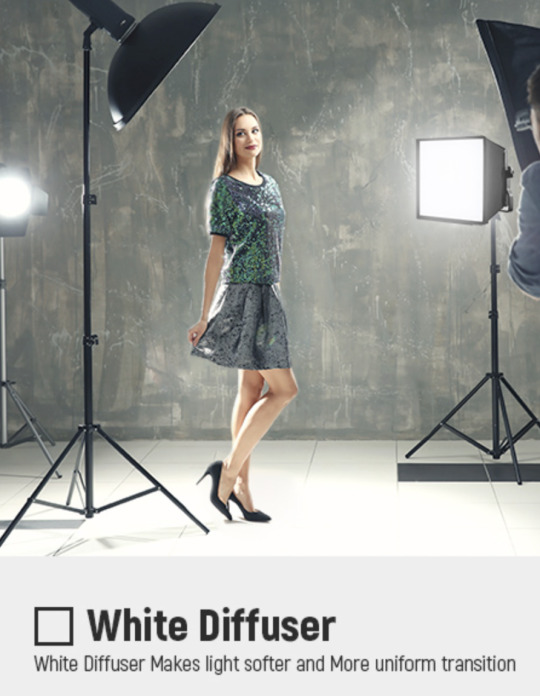
And while that is *technically* true, I'm afraid people are going to be disappointed if they think this thing is going to dramatically soften their light. A small increase in surface area like that would only be dramatically different if you were lighting a little toy car or the hypothetical ant friend I mentioned earlier. Something the size of a person is not going to see a difference in softness. Not to mention you are going to decrease the power of your light by adding diffusion and have no softening benefits.
Photography gear companies love taking advantage of new photographers because the desire to buy more gear to improve the quality of photos is quite strong. This is jokingly referred to as G.A.S. or "Gear Acquisition Syndrome." And while there is absolutely gear you can buy to improve your photos (lights, lenses, tripods), knowledge trumps any piece of gear at any time.
So, no, this scam softbox will not make the light appreciably softer. The only way to make this light softer is to find a softbox that enlarges it more than 2 friggin' inches, bounce it off something larger, or bring it closer to the subject. Move your light as close as possible and you will enlarge its apparent size.
Or, conversely, you can move your light farther away to make it hard.
Meaning you can technically make a softbox a hardbox.
Seriously, can we just do the whammy box thing?
So, what have we learned?
Soft light is more flattering to skin and reduces texture and harsh shadows.
Hard light increases contrast, sharpens shadows, and highlights texture.
Neither is good or bad. Soft light can be boring. Hard light can be interesting. A mixture of the two often produces the best result.
The only way to make light softer is to enlarge the light source.
You can enlarge a light source by...
Increasing the physical dimensions with a modifier.
Moving the light closer.
Reflecting the light off a larger surface.
Diffusion alone does not make a light softer.
Diffusion makes a light source more homogenous by mitigating hotspots.
Softboxes create homogenous light that you can direct and focus.
A softbox can still produce hard light if it is really small or really far away.
We should call it a whammy box.
How can you use this knowledge?
Well, the first thing you can do is...
DON'T BUY A RING LIGHT.
YES, I AM RANTING ABOUT RING LIGHTS AGAIN!
That giant hole in the middle of your light is a great spot for extra light.
And as we just learned, a larger light source is softer. So unless you specifically need a ring light and know how to use it (facial close-ups, camera goes in the hole), you are better off getting the biggest light you can fit in your space.
Look at how much bigger this light is than if it were a ring light.
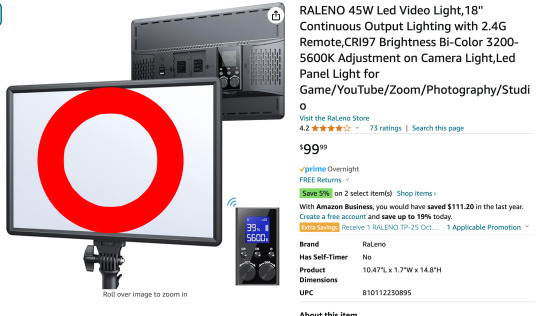
It's like all of these influencers are throwing perfectly good light into the garbage.
Sorry, let's try this again.
Once you avoid ring lights, how can you use this knowledge?
I know a lot of you reading this are not influencers or YouTubers or photographers. And you may be thinking all of this knowledge I just shoved in your dome is useless.
But here's the thing...
We all take photos.
And I think we all want our photos to look their best.
If you start thinking more about light when you take photos, I promise you will be able to improve their quality.
If you are taking a selfie, think about where you can go that has a larger light source. Perhaps you have a large window. Or you have a big overhead light or floor lamp that shines up into the ceiling.
I actually had this idea to create a mega light that could blend in with a house's decor, but secretly be a photography light for taking pictures of people and pets indoors at night.
Secret Photography Light Ingredients Cheap Floorlamp Dual Light Socket Adapter 9000 Lumen LED Bulbs
(Seriously, if you put that together, stick it in a corner, and turn it on when your kids or pets are playing, you will never have another blurry photo from inside your house unless they are going full zoomies.)
If you are outside on a sunny day, don't stand in direct sunlight.
Remember, THE SUN IS ACTUALLY SMALL, angularly speaking. Find a shady spot under a tree. Or put the sun behind you and face a big white wall so the reflected light smacks you in the face.
Walls are light sources!
The ground is a light source!
Remember that moon photo?

You were looking at the sharp shadow earlier because I drew your attention to the sun being a small light source.
But the surface of the moon... HUGE LIGHT SOURCE.
How do you think the front of that space suit is lit when the sun is behind him? Either Stanley Kubrick has a big reflector offscreen or the ground is a soft second light source.
If you can't make it to the moon, just wait to take that selfie on a cloudy day. I think overcast light is a little boring, but your skin will look buttery smooth without using those stupid Facetune apps.
You can also wait for good light. Sometimes sunset has some nice, soft directional light because it has more atmosphere to scatter, diffuse, and enlarge it.
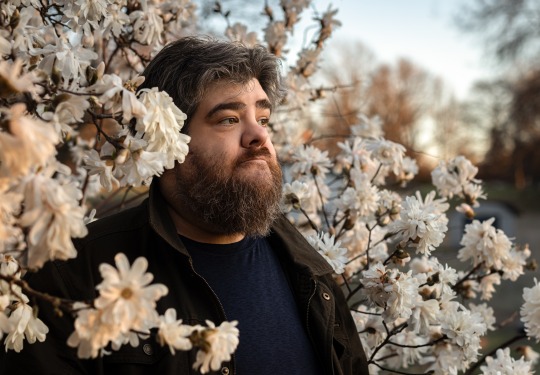
If you are indoors, don't use direct flash on your phone. Never ever use direct flash if you can avoid it. But perhaps you are with friends and they all have phones too. Use one or more phones to bounce the flashlight off a nearby wall. Or open up a paper napkin and hold it just out of frame and shine light through it and diffuse it.
A piece of paper can even work!
Flashlight 3 feet away shining directly onto my face...
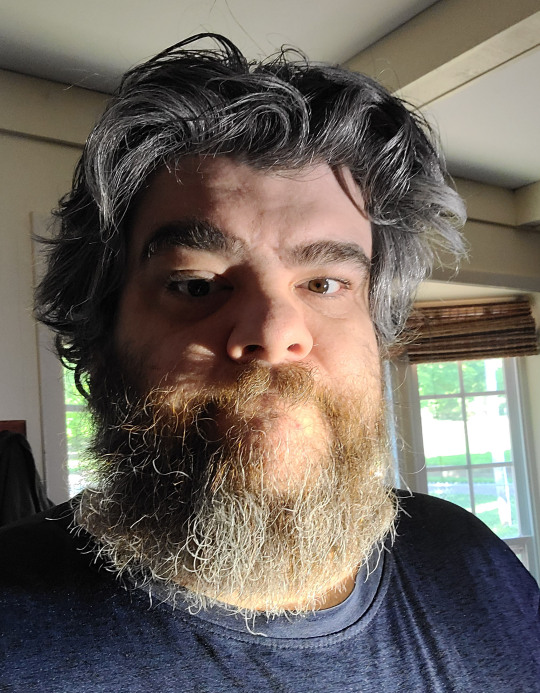
Flashlight shining through a piece of paper a few inches in front of it...
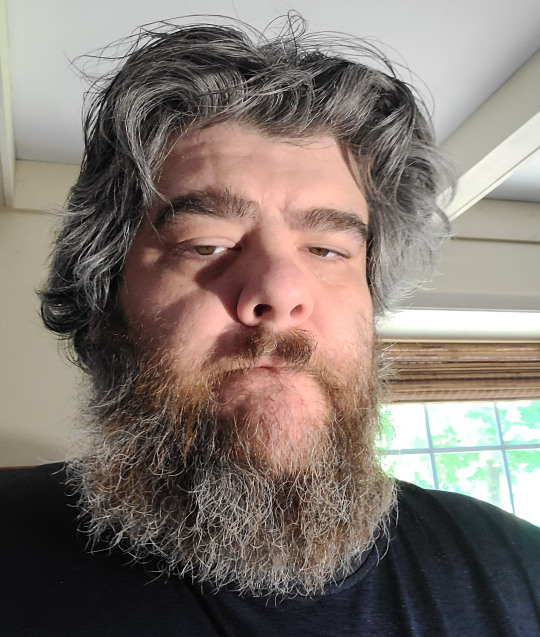
Flashlight shining through a piece of paper 2 feet away that is just out of frame...
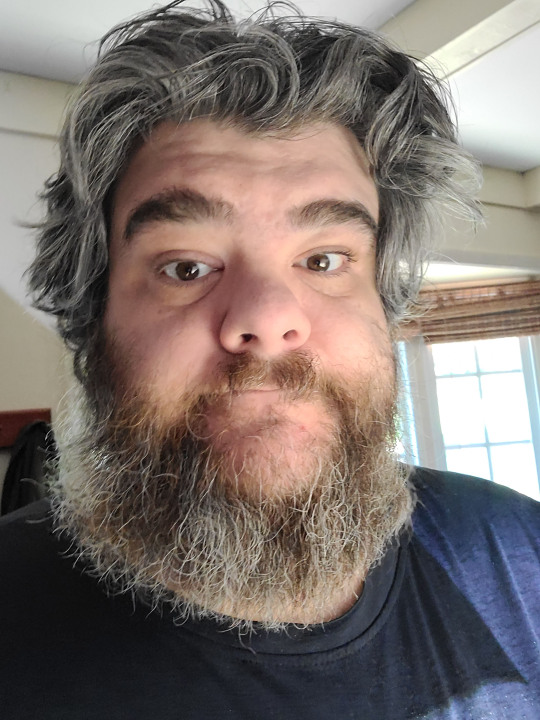
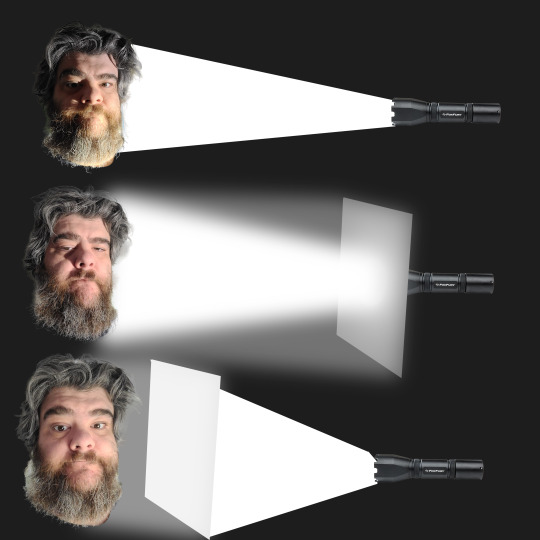
I started with a small light source.
I then made the light source a little bigger with the paper, but the diffusion was too close and it created the dreaded hotspot of doom.
And then I made the light source as big as I could by moving the paper as close to my face as possible without being in the shot. This also gave the light more room to scatter and diffuse making it homogenous.
Froggie Tip: I was using a pretty powerful flashlight, so with a phone you might get better results *bouncing* the light off the paper rather than shining the light through the paper.
So, before you take a photo, just think about how you can make your light source bigger, brighter, and more homogenous and you might be surprised how much better you look.
ANYONE CAN DO THIS!
800 notes
·
View notes
Text
With the WGA and SAG-AFTRA on strike, I want to take this moment to talk about one really important thing that I've alluded to but haven't gone into depth on, and people don't like to hear because of a lot of the noise, but-
We need to also support VFX unionization efforts (everyone's with me so far right...?), and in doing so, acknowledge the labor actually involved in using new technology (not just AI, but whatever the NEXT big breakthrough is too, and the one after that, and the one after that, indefinitely) and credit the people operating it properly-
Aaaand I've lost some people, but hear me out.
Sure, it's easy to type a single prompt and get a result that looks kinda nice. "Kinda nice", however, isn't going to cut it for most productions! It's like photography that way. As ubiquitous as good-quality cell phone cameras are, anyone can just point and click with some very basic understanding of what makes a passable composition and get something that's pleasant on the eyes.
And yet, generally speaking, people aren't grabbing random people with cell phones off the street to shoot movie posters! Because even a layperson can tell the difference between the photo you get when you stop a random stranger on the street and ask them to take a photo of you and your friends together, and the photo you get when a trained professional sets up the actors in a studio, with deliberate lighting, a thorough understanding of what lens(es) to use, and so much more.
Photography is easy. To be able to get a professional quality result? Not so much. Sure, sometimes a total rando who barely knows how to use a camera will luck out and get the shot of a lifetime - but it sure doesn't happen often and you DEFINITELY can't make a whole profession out of hoping for it.
The same goes for AI.
Most singular AI pieces that are high enough quality to get people really excited take hours, and hours, and hours of work and refinement and retrying and tweaking to get right. I mean, go test out a free image generator and pay attention - you might get a lot of results that look fun just by typing in a very silly prompt, but good enough to be a major part of a movie without any alteration? ....maybe one in a million - and then you still probably have to upscale it! And the standard for "nice to look at for a moment" vs. "good enough to be a major part of a professional production" will only get stricter and stricter as things get more saturated and people see Default Midjourney Style or the like as being super boring and amateurish for anything bigger than a literal one-man production, too (which sucks on a tiny level for me personally because I like Default Midjourney Style, but that's not important).
I point this out because bringing this up in the context of unionization helps to kill the entire motivation behind using AI to undercut manual art. The higher-ups want the world to think it's just mindless, super-easy button-pushing that anyone can do, so it's fine to crunch people even HARDER than they already crunch VFX artists or outsource it to people they can pay subminimum wages, right?
It's not. It never is. It never will be. We need to cut it off at the pass before one more studio even fucking tries it.
331 notes
·
View notes
Text
A Question A Day, July 2025: Characters
31 questions to help you post about your characters every day in the month of July 2025.
01. If your character was to live in your favorite tv show or movie's world, how would their life be different? How would they be different? How would they get along with the main cast of the show or movie?
02. Does your character have special tricks they like to do to show off? If yes, what are they?
03. What is your character's favorite subject for photography? Do they prefer photography of animals, weather patterns, the sky, nature, people, events, sports, etc?
04. How many languages does your character know? What made them decide to learn them (if more than one)? Did they learn them for fun or out of necessity? How fluent are they? Are they better with written or verbal speech?
05. What is the most insane thing your character has done for attention?
06. Does your character prefer their SOs older or younger or the same age? If they don't date, then same question but for close friends.
07. If your character was to rename themself, what name would they pick? What's the significance of the name?
08. What are some of your character's guilty pleasures? How many people know about them?
09. How many relationships has your character been in? Which one was their favorite? If that one ended, what happened to end it?
10. Is there a certain restaurant or type of food that your character tends to crave a lot? What is it? Is it based off of a real restaurant or is it made up?
11. Is your character the type to believe in astrology? How far does their belief go, if they do? Do they read horoscopes? Do they actually believe their horoscopes to be real?
12. What form of science most fascinates your character? How much of a curious person would you say they are?
13. Which of your character's (own) physical features do they find the most attractive/are they the most proud of? Which side of their family did they get it from? How far down their lineage do you have to go to find someone who shares it (for instance, my eyes come from my maternal grandmother)?
14. Reblog a post that you feel really encapsulates the essence of your character. Explain in a separate post (unless you reblog your own post, then you can just do it on the reblog) why you chose that post for them.
15. If your character was to run a blog on tumblr, what kind of blog would they run? Would they post a lot or be someone that posts every once in a great while? Would they only have one blog or multiple? Would they have multiple accounts so they could have multiple main blogs?
16. What fandoms would your character be part of if they lived in the real world in modern times?
17. How difficult is it to earn your character's trust? Who do they trust the most and what caused them to trust this person so much?
18. How often does your character have time to do their favorite hobbies? How much time at a time do they put toward it (ie an hour in one sitting to do their favorite hobby)? What is the hobby?
19. Would your character be an android or an iPhone person or would they be the person that uses some obscure phone that no one's ever heard of?
20. What is your character's view on technology?
21. What is your character's favorite breed of dog? What draws them to this breed? Do they tend to prefer big, medium or small dogs, in general?
22. What are some of the differences in how others around your character view them vs how the character views themself? Which view is more accurate of how they actually are? Do their actions match their speech? Are they consistent or do they tend to be more random in action? How about in speech?
23. How frequently does your character go to the place they were born? Do they travel much? If so, where all have they been? What's their favorite place they've been to?
24. What is your character's favorite first-date question to ask? How do people respond to their answer to the question?
25. What was the most tragic thing to happen to your character? Where in the process of healing from it are they? What steps have they taken to try to heal from it? How do they react to people talking and/or asking about it?
26. How health-conscious is your character? What are some of their good health habits and what are some of the bad ones?
27. What are some of your habits that you know your character would have Something to say about? What would be your character's advice to you if they were to give advice on how to kick the habit(s)?
28. What is your character's favorite activity to do with their partner?
29. What pet names does you character love? Which ones do they hate? What nicknames have they given to their partner that isn't quite a normal pet name?
30. When handwriting, does your character have a preference on what color ink pen they use? Do they prefer pens or pencils? If pencils, do they prefer mechanical or number 2 pencils?
31. Which classic tv channel would be your character's favorite if they lived in real life?
#writers of tumblr#writer questions#daily questions#daily prompts#prompts for writers#july 2025#questions for july
4 notes
·
View notes
Text
good afternoon i am here to drop off an extensive list of h/azbin snz 'prompts' directly from my Notes, cause i had to cut a TON of stuff out of my list of things to write (it was getting far too long) but i still felt like these Deserved to be seen and ive seen a few other people put up prompt lists so-
long explanatory ramble aside boom here's the list;
A/lastor, as we all know, HATES modern technology. what if... there was another reason he despises flash photography... (aka, photosensitive!A/lastor).
this is less of a prompt and moreso something i think would be neat to see... mayhaps, some S/era snzfic?? idk, i think there's potential there
L/ucifer being sick during one of the meetings at hell's Heaven Embassy.
V/ox vs A/lastor vs A/dam vs L/ucifer. i don't actually remember what this prompt was about i just think the four of them arguing ft. some kind of snzkink stuff going on would be really fun. bonus if at the start A/lastor and L/ucifer are arguing while V/ox and A/dam are Teamed Up, and then by the end A/lastor and L/ucifer are teamed up while V/ox and A/dam are arguing-
Initially, after falling, L/ucifer was allergic to more sinful/demonic stuff. As time went on these allergies faded, and he ended up developing allergies to more holy stuff. The existential/identity crisis he went through when this started to happen was intense. ft. L/ucifer sneezing fire for the first time and scaring the hell out of both himself and L/ilith
C/harlie was given some sort of allergy pills before leaving to Heaven, so that she wouldn't be bothered by all the holy stuff there. V/aggie didn't take any cause she believed she wouldn't need them. This was a mistake.
A/lastor with a dog allergy. C/harlie brings a hellhound (or something like that?) to the hotel. I don't think this one requires any further elaboration.
L/ucifer constantly wears this apple scented perfume/cologne for the Vibes. he's secretly mildly allergic/sensitive to it. (as in, it'll set him off when recently sprayed, but it's fine once it's Been a Bit. this usually adds an hour (or more) to his morning routine).
what. what if messing with A/lastor's shadow could make A/lastor himself sneeze. like as in, if A/lastor's shadow went over a dusty shelf or something, it'd make the shadow sneeze, which would then make A/lastor sneeze??? idk i just think it could be fun
idk why the idea of A/ngel Dust, H/usk, and C/herri bringing L/ucifer to a club only for him to either be a) hiding that he's sick or b) allergic to the drinks/a sneezy drunk (or whatever you call it?) is so fun to me but it IS
C/herri should be allergic/sensitive to smoke i think. i think that'd be really fun.
this one's just cause i think it's a funny scenario but; L/ucifer outright being allergic to soul deals-
A/ngel and H/usk feel the most like caretakers to me, so whenever they get sick, especially if it's at the same time, everything dissolves into chaos from everyone else trying to look after them
#H/azbin H/otel#snz#snz fic prompts#i KNOW there's a lot of L/ucifer on here but i just love him a lot
32 notes
·
View notes
Text
a little rant about ai "art"
Many creatives are being actively steered away from creative fields for the purpose of living for a wage instead of living for the art. Just within my friend group leaving high-school (where all of them were creatives, artists, and musicians) of 15, only 5 pursued the arts as a post secondary, the others pushing art aside to be just a hobby, or forgetting and losing it entirely. The unsteady job market has always been a universal truth for artists, however it was always a thing we could keep going at, because while it may not pay much or be harder to “break in” so to speak, there would always be art that needed to be made (graphic design, visual art, photography, video editing, animation, etc.).
Meanwhile developing artists have been fed AI “tools” in their art programs and softwares, and are never learning the true facet of art: that everything has a process, and you have to learn the rules before breaking them. The continuing prospects of AI taking over/replacing artists will discourage new artists to start, thus leading to the loss of a talent so entwined with human history.
Generative AI – while created at a time that it was a gimmick and a novelty – with the way it has developed and grown, has been taken by many members of this capitalist society as a shortcut to cutting costs, as they can “ethically” cut labour costs. However, their ethics of these cost cuts are simply swapping one bad thing for another: underpaid labour vs intellectual property theft and the ecological concerns brought on by data centers. With the intrigue and allure of making “free” art, the rate at which artists are being hired, commissioned, and even considered is declining at a concerning pace, posing the question: Why do we value needless, and harmful technological "advancements" over the wellbeing of humanity?
Because of generative ai, and ai “art”, in the scope of human history, from this moment on, books, literature, and art, will have an asterisk beside their title reading: *could have been made by a computer.
This creates the problem seen already in human history, with burning of the Library of Alexandria; jealousy and hatred – of the containment of great knowledge, individualism and world perspectives, and the need to seek art out from those trained and talented in the craft – leading to the desecration of works of immense artistic quality and historical value. And while the art (that was unwillingly) used to feed these machines still exists, the artists who created the works no longer have true private ownership of their work, and their contribution to history gets lost in some database that generates more “art” than humanity has the emotional capability to care for.
Even though the blame for the burning of the books, is unplaced and unknown definitively, the loss of the knowledge – contained within the books or of the creation of art – can only be attested to by the ones who committed themselves to the process of learning, and intern cannot be known by the ones who decided the knowledge should be theirs without cost.
Meaning of art is tied directly to the humanity and nature by which the artist expressed emotion through a piece. Art is made in the nuance, it is made by the mistakes, by the hand, and by the thought process it took to get there.
When all is said and done, “AI “artists”” will have no personal hand in the creation of the work, and are liars and thieves with no legal claim over a computer’s take on the prompt it took them less than a minute to enter.
also all excuses and justifications made to defend AI “art” are flimsy at best and stupid 😘✌️
Sincerely,
a tired artist who is so fucking done with this shit
#ai art is not art#ai discourse#artists on tumblr#im fucking mad#ai art isn't real art#ai art is theft#fuck ai art#art#who radicalized you#i watched wall e when i was a kid and understood it#loser#rant post
4 notes
·
View notes
Text
Musk vs NASA
I found this on Mastodon, so it’s a copypaste – please go read the original post by Amata/@[email protected] (no login required)!

I've been seeing hate on NASA lately, being bought into by leftists even, and I just want to point out something very important:
Musk has hated NASA for a *long* time. There is a reason it is being attacked, and a reason public opinion is being swayed against NASA: It *keeps SpaceX in line* more than anything else.
NASA is being seen as "competition" to SpaceX, as the obstacle in his way. It has been like this for quite some time, and now, with DOGE and other things, he can do something about it.
I would like to point out a few things:
1. SPACEX IS NOT CHEAPER They boast they can "do what NASA does for 10% the cost!" Sure, it's easy when you did none of the R&D. SpaceX saved on: Landing tech: DC-X project in 1991-1996 Tank structure: Shuttle SLWT tank, 1998-2011 Merlin Engines: direct descendant of the Fastrac Engine, 1997-2001.
Those three things alone saved SpaceX over 90% of the R&D costs. It's easy to "appear" cheap when you're using off the shelf tech someone else (NASA!) developed.
2. NASA IS GREAT FOR THE ECONOMY! For every $1 spent on NASA, $8 is put into economy. Its stupid to not invest in that kind of ROI! 800%! At times, its ROI Has been 1600%!
Simply put, if you defund NASA, the economy would shrink so much you would actually have to RAISE taxes to make up for the lost revenue, and without its existence we would be 30 years behind in technology and the quality of life for everyone would be much lower. Science and research is GOOD for society, it's the fuel for all progress.
3. WHAT HAS NASA DONE FOR ME?! (Surely you just mean NASA is good for tech & science folk....)
Nope! Good for all! Ever have an MRI or CAT Scan? They wouldn't exist without the Apollo program! The software that made them possible was originally written to analyze lunar photography.
Low power digital x-Rays was planetary body research.
Heart pumps are modeled after space shuttle turbopumps.
The software that designed your car was originally written to design spacecraft!
Who do you think pioneered all the early research into alternative power like solar panels, hydrogen fuel cells, and durable batteries? NASA!
NASA developed tech and satellites is also what improves agricultural yields while reducing the needs for water, fertilizer, and pesticides.
Do you really think Musk gives two shits? No. He wants the money, he wants to let SpaceX run amok without any oversight for safety, without any "competition".
All fights are important, but do realise that this one is a huge thorn in his side, and one that is keeping a huge problem from ballooning and swallowing us all whole.
Do not be fooled or swayed by lies, of tactics meant to divide, of things being done to make you be angry at NASA. If he can make you hate NASA, he won.
Expect far more space junk to fall, the night sky to be ruined by satellites, and the loss of all things good that proper research and design does for humanity and gives back to the world. Not to mention: enjoy seeing the horrible things he can accomplish fully unchecked.
ETA: Now that you know, call / fax / email your senators and reps, and whatever else too! Boosting gets people thinking, but thinking is not action!
5 notes
·
View notes
Text
For More Videos Click On Below channel link--https://www.youtube.com/@technicalindiahub
Watch this if you want to buy vivo x series #vivo#vivoxseries#camara#smartphone#technology
In this video, we go deep into the final face-off: Vivo #x200 vs Vivo #x200pro Both top-of-the-line #smartphone released in late 2024 offer top-notch #features , but which one should you pay for? We #compare all — #design , display, #performance , camera, #battery , and charging.
The Vivo X200 has a 6.67" AMOLED display, MediaTek #dimensity9400 chip, and a good triple 50MP #camera setup. The X200 Pro ups the ante with a 6.78" display, #sony LYT-818 sensor, a humongous 200MP telephoto lens, and Vivo's proprietary V3+ imaging chip for pro-grade photography. #battery life?
The X200 #features a 5800mAh battery with 90W fast charging, while the X200 Pro boasts a 6000mAh semi-solid battery with 90W wired + 30W wireless charging.
Starting at a price of ₹65,999 for the X200 and ₹94,999 for the X200 Pro, is it upgrade-worthy? See the video to determine which one fits your #style and requirements.
Don't forget to #subscribe , #like , and hit the bell icon for more tech comparisons. #share the #video . #vivox200 #vivox200pro #smartphone #comparison #vivoindia #techreview #cameratest #vivo #tech #mothersday #look #shorts #youtube #gift #ideas
2 notes
·
View notes
Text
"Does the Redmi Note 13 Pro+ 5G offer the best camera and performance in its price range? Explore its features and specifications!"
Redmi Note 13 Pro+ 5G – The Best Mid-Range Smartphone of 2024!
Introduction
Redmi Note 13 Pro+ 5G Review :
Xiaomi has launched its new Redmi Note 13 Pro+ 5G phone with premium features in the mid-range segment. With 200MP Camera, Dimensity 7200-Ultra Processor, 120Hz AMOLED Display, and 5000mAh Battery, it is considered as the Best 5G Phone under ₹30,000 in India. In this Redmi Note 13 Pro+ Review Kannada article, we provide complete information about its Performance, Display Quality, Camera Features, Battery Life, and Price in India.
Redmi Note 13 Pro+ 5G Specifications
Processor: MediaTek Dimensity 7200-Ultra (6nm Chipset)
Display: 6.67-inch Curved AMOLED with 120Hz Refresh Rate
RAM & Storage: 8GB/12GB LPDDR5 RAM, 256GB/512GB UFS 3.1 Storage
Battery: 5000mAh Battery Life, 120W Fast Charging
Camera: 200MP OIS Primary Sensor, 8MP Ultra-Wide, 2MP Macro
Operating System: MIUI 14 based on Android 13
Connectivity: 5G, Wi-Fi 6, Bluetooth 5.3, IR Blaster
Redmi Note 13 Pro+ 5G Display & Design
The Best AMOLED Display Phone under 30K, Redmi Note 13 Pro+ 5G has a 6.67-inch Curved AMOLED Display that supports 1.5K Resolution and 120Hz Refresh Rate. HDR10+ technology, Dolby Vision, and Corning Gorilla Glass Victus protection enhance its Premium Look & Durability.
Redmi Note 13 Pro+ 5G Performance
This phone is perfect for Gaming, Video Editing, and Multitasking with Dimensity 7200-Ultra Processor. High FPS Gaming like BGMI, COD Mobile, Asphalt 9 etc. can be performed on Ultra Settings on the phone.

Redmi Note 13 Pro+ 5G Battery Life & Charging
Hailed as the Best Fast Charging Phone 2024, the Redmi Note 13 Pro+ 5G has a 5000mAh battery and supports 120W HyperCharge. 0% to 100% Charge in 19 Minutes is possible!
Redmi Note 13 Pro+ 5G Camera Quality
Best Camera Phone under ₹30,000 Redmi Note 13 Pro+ 5G supports 200MP OIS Primary Camera, Ultra-Wide Lens, and 4K Video Recording. Super Night Mode & AI Photography Enhancements optimize this phone's camera.
Redmi Note 13 Pro+ 5G Price in India
Redmi Note 13 Pro+ 5G Price in India starts at ₹29,999. Exchange Offers & No-Cost EMI Available on Flipkart, Amazon, and Xiaomi Store.
Final Verdict – Is Redmi Note 13 Pro+ 5G Worth It?
Those looking for Best 5G Phone under ₹30,000 in India 2024 can buy Redmi Note 13 Pro+ 5G. Curved AMOLED Display, 200MP Camera, Long Battery Life, Fast Charging, and Gaming Performance makes it suitable for Tech Enthusiasts, Gamers, and Photography Lovers.
FAQs – Redmi Note 13 Pro+ 5G Review
Q1: What is the Redmi Note 13 Pro+ 5G Price in India? A: Available between ₹29,999 - ₹32,999 in India.
Q2: Redmi Note 13 Pro+ vs iQOO Neo 7 Pro which is better? A: iQOO Neo 7 Pro is better in Performance & Gaming, but Redmi Note 13 Pro+ 5G is stronger in Camera & Display.
Q3: How much is Redmi Note 13 Pro+ 5G Battery Backup? A: Having a 5000mAh Battery is an alternative for 1.5 Days of Normal Use.
2 notes
·
View notes
Text
Public vs private knowledge ( Pokémon verse )
Note: any worldbuilding details here are open to discussion to better meld with your headcanons!


Public knowledge ( information everyone can know )
Prompto Argentum is a recent member of the Galarian kingsguard.
By way of Noctis sharing his power with his friends, Prompto can also materialize weapons. He cannot warp, however; only Noctis can.
Prompto is trained with and licensed by the kingsguard to wield firearms. Under Galarian gun law, he is only permitted to shoot in life-threatening situations.
Prompto has a shiny Altaria named Sunny, an Armarouge named Ember, an Inteleon named James ( he jokes that his full name is "James Pond" ), and depending on the point in the timeline, an Espeon named Pryna.
Prompto attended the same school as Noctis and is his best friend.
Prompto loves photography and would like to do it professionally in the future.
Prompto works out. He enjoys running and will periodically go on morning runs with his Pokémon.
He has his finger on the pulse of modern technology. Noct considers him a "technophile."
He ADORES Pokémon and gets easily excited around them.
He can't cook to save his life.
He can drive. He's not very good at it though.
He has a barbed wire tattoo wrapping around his left wrist, and a star right above it on the back of his hand.
His Rotomphone is the same royal make and model as Noct's.

Semi-private knowledge ( information select groups know )
Prompto was adopted out of Kalos as an infant by a family from Wyndon.
After helping an injured Eevee as a child, he eventually learned that Eevee belonged to Lunafreya, who sent him a letter as thanks and asked him to befriend the withdrawn Noctis at school.
Ember has been with Prompto for as long as he can remember. His parents say that Ember was with him when they adopted him.
Prompto is not especially close with his parents.

Private knowledge ( information only Prompto and loved ones know )
Amid Prompto's freckles, there are a few dots that stand out more prominently as being...well, not freckles. He's written these off as a weird birthmark.
As a child, Prompto was quite shy and had difficulty making friends. He kept to himself and found solace in taking photos.
Prompto started running after an awkward attempt at befriending Noctis as children went awry. He tripped and fell, and Noctis remarked that he was "heavy" upon helping him up. After this encounter, Prompto resolved to lose weight and work on his shyness in order to become someone the prince would want to be friends with. He eventually grew to enjoy his runs independently of his initial motivation for starting them.
Prompto's love for photography was helped by progress photos he took on his weight loss journey.

Secrets ( information ONLY Prompto knows )
Prompto is deeply insecure about his status relative to his friends. Being of common birth, he feels like a fish out of water with his noble-born friends.
He secretly worries that if his friends were to learn about his hangups, they would leave him.
Occasionally, Prompto hears whispers from Pokémon's hearts and crystals. This is a rare occurrence he doesn't understand. Given that Ignis and Gladio can't hear them, he's concluded that the phenomenon is not a result of Noct's powers. He's too afraid to ask him to confirm.

Depths of the Iceberg ( information not even Prompto knows* )
*He might know these, depending on the point on his timeline a thread takes place at. He may have also told his friends about this information at later timeline points. Generally, though, he doesn't know this information by default.
Prompto is a clone of Verstael Besithia, resulting from Lysandre Labs' duplicative project.
As an infant, an Interpol agent operating on a tip broke into Lysandre Labs' lower levels, absconding with Prompto and Ember. The agent entrusted him to the people that he would eventually call his adoptive parents.
Prompto's classification in Team Flare's database is RP:D:3234.
His "weird birthmark" is actually Team Flare branding.
He has a tracker injected into his right wrist, but given that the technology predates the one in Silva by eight years, it's less refined. Over the years, it eventually broke.
In threads set after Prompto's eventual recapturing by Lysandre, he has this tracker replaced.
Prompto's ability to intermittently hear the hearts of Pokémon and crystals is a result of Team Flare experimentation after he turned out to be a stable and successful clone.
8 notes
·
View notes
Text
Round 1D
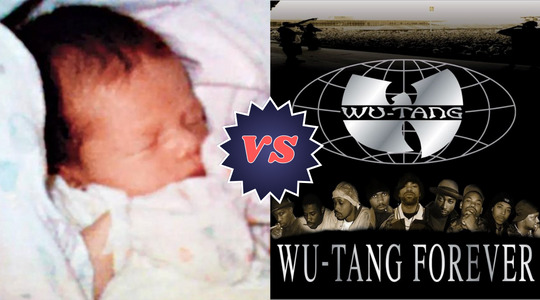
First Cell Phone Photo: Imagine a time when you carried a Nikon CoolPix in a protective case to capture your most momentous occasions... now count how many pictures of sandwiches are in your phone's camera roll. On June 11, 1997, Philippe Kahn captured a historic moment using his Motorola StarTAC mobile phone, his laptop and a custom software application he had developed. The photo was of his newborn daughter, Sophie, and it was sent to friends and family to share the joyous moment. This pioneering act marked the birth of "instant visual communication" through mobile phones, laying the foundation for the proliferation of camera phones and the way we share images in the modern digital age. Kahn's invention and the "first cell phone photo" it produced hold a significant place in the history of photography and mobile technology.
Wu-Tang Clan's Wu-Tang Forever: Wu-Tang Forever is the second studio album by the American hip-hop group Wu-Tang Clan, released in 1997. This double album is a seminal work in the realm of East Coast hip-hop, renowned for its dense lyricism, gritty production, and intricate storytelling. It features all nine original members of the Wu-Tang Clan, including RZA, GZA, Method Man, Raekwon, and Ghostface Killah; the album's production, largely handled by RZA, is characterized by its distinctive blend of soulful samples and martial arts-inspired sound bites. The album not only solidified the group's status as one of hip-hop's most influential acts but also expanded the boundaries of the genre, offering a complex and multifaceted exploration of themes like street life, spirituality, and the struggles of urban existence. While sales did not match their late peers Tupac and Biggie, critics were largely more favorable to Wu-Tang: Melody Maker wrote "It had to be this big. It didn't have to be this good. Every single track is a detonation of every single pop rule you thought sacrosanct. Wu-Tang Forever is one of the greatest hip hop LPs of all time."
9 notes
·
View notes
Text
Camera Apps for Photography: Unleash Your Inner Ansel Adams with Your Phone
Let's face it, our phones are practically extensions of ourselves these days. And with the ever-evolving technology packed into these little devices, they've become powerful photography tools as well. But with so many camera apps flooding the app stores, where do you even begin?
Fear not, fellow shutterbugs! This guide will equip you with the knowledge to navigate the world of camera apps, helping you choose the one that unlocks your photographic potential.
Built-in vs. Third-party Apps:
Most phones come with a decent built-in camera app. It's a great starting point for capturing everyday moments. But if you crave more creative control, venturing into the world of third-party apps is the way to go. These apps often offer a wider range of features, from manual shooting modes (think adjusting aperture and shutter speed) to advanced editing tools.
Choosing Your Weapon:
The "best" camera app depends on your skill level and photographic goals. Here's a breakdown of some popular options:
For Beginners:
Open Camera (Android): This free app offers a user-friendly interface with a surprising amount of manual controls, making it a great choice for beginners who want to experiment beyond the basic point-and-shoot functionality.
Camera FV-5 Lite (Android): Another free option, Camera FV-5 Lite provides a comprehensive set of manual controls in a sleek interface. It's a good fit for those who want to delve deeper into exposure settings.
For Enthusiasts:
ProCamera (iOS): This app boasts a clean and intuitive design with a powerful set of manual controls, making it a favorite among iPhone photography enthusiasts.
Manual Camera DSLR (Android): This app lives up to its name, offering a DSLR-like experience on your Android device. With features like RAW capture and focus peaking, it allows for precise control over your shots.
For Social Media Mavens:
VSCO (iOS & Android): This app goes beyond just a camera. VSCO offers a fantastic selection of film-inspired presets and editing tools, perfect for creating those eye-catching social media posts.
Snapseed (iOS & Android): A free app from Google, Snapseed is a powerful photo editor that allows you to fine-tune your photos with a variety of tools and effects.
Beyond the App:
Remember, the app is just one piece of the puzzle. Understanding the fundamentals of photography — composition, lighting, exposure — will take your phone photography to the next level. There are many excellent online resources available, like Wikipedia's article on photography to get you started.
So, unleash your creativity, explore different camera apps, and don't be afraid to experiment! With a little practice, you'll be capturing stunning photos that rival those taken with traditional cameras. Happy snapping!
2 notes
·
View notes
Photo
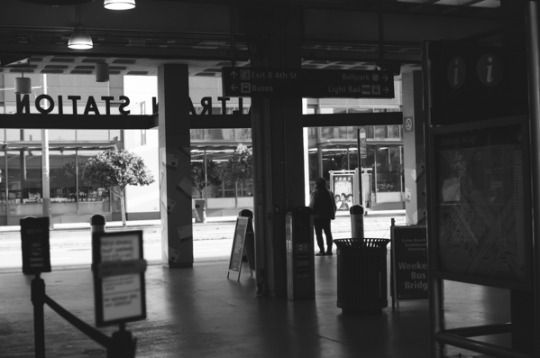

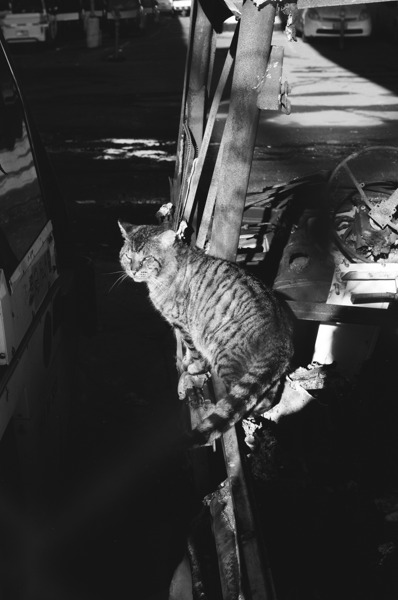
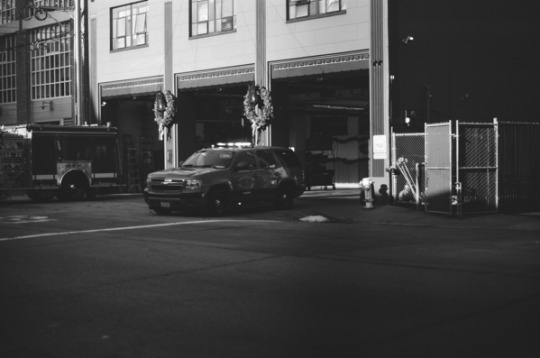
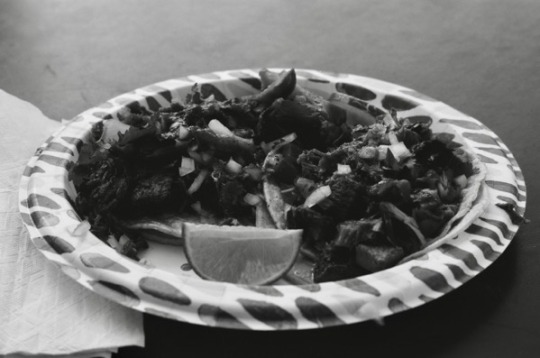
Being an “elder millennial” or “Xelennial” or whatever label you want to call someone born in the 80s that got to play the original Oregon Trail, I got to see a lot of technological transitions. Growing up, we had film cameras. Point and shoots, mainly, with some oddballs here and there (remember those cameras that were flat and long?). At some point while I was a teenager I was gifted a used Fuji STX-2 and I became the family photographer. From that point forward I took more photos than was in them. That camera, sadly, is no longer with me. I’ve since moved on to a Canon K2 and then later a Canon Elan7 which I continue to use today (which is actually my second Elan7 after my first one met with a terrible fate).
I went to film school (the motion kind), but never really got a chance to be a “filmmaker”, for whatever that means, so I use photography as a way to exercise that muscle a bit. Aside from sharing some shots on Flickr and a few things on Instagram, I’ve never really shared my photography with anyone other than my partner, so I’ve not really worked on talking about my process or really looked at my photography objectively. Over the next year my hope is I can start being more thoughtful about the photos I take and forcing myself to write about them here might help with that.
This past month I picked up a Fujica ST801. I mainly bought it for the lenses (I’ve been collecting old, mostly soviet M42 mount lenses), but the camera is actually a fantastic little device. The shutter and the film winding lever are wonderfully mechanical. Given it’s a Fuji camera, I thought it appropriate to start off with a roll of Fujifilm Neopan Arcos 100II as my test roll. Part of the “joy” of eBaying cameras and camera equipment is not fully knowing if what you’re going to get is actually as functional as the post made it seem. In this camera’s case, the light meter is subtly messed up, but I don’t know yet if it’s because something’s actually wrong or if it’s because it’s actually meant for silver oxide batteries and I’m using alkaline. As a result, I ended up having to use a light meter app on my phone. I should probably get that fixed.
Here’s a selected few photos from that roll.
Image 1, the Caltrain station
I've never really shot this stock before despite shooting a lot of black and white film. This stock has a lot of dynamic range and not a lot of grain, which I actually really like. I actually really like this composition, though I keep waffling back and forth on whether I should have tried for a deeper depth of field or if I actually like that the foreground is out of focus.
Image 2, more caltrain station
This is a lot closer to the "style" I normally shoot, quote unquote "street photography". I like the person in the shot, and I like the deep hallway. I don't like that I don't have any of the next train signs in focus. Again, this was a pretty challenging lighting situation, and with a broken meter, I just went with a wider open f-stop.
Image 3, cat on a bombed out metermaid vehicle
As I was walking down the street I saw a flock of metermaid vehicles parked behind a fence, which was interesting enough, but as I got closer, I spotted a cat who seemed to be offended that I made eye contact. The vehicle it was sitting on seemed to be having a rough go at it, what with being burned and all, but it made for a fascinating subject. This is another one where I was impressed by the dynamic range of the film. The cat is well lit, but you don't lose all of the detail in the vehicle either. I actually have three pictures of this cat, but this one stands out the most because of the contrast in the shadow area vs the cat. A+, would potentially offend this cat again.
Image 4, fire rescue racing out of firestation
I don't know if "lucky" is the right word, considering emergency vehicles racing off is typically not a good thing, but I happened to grab this shot while walking by a fire station just as they received a radio call. This is probably the one time I regret having black and white instead of color loaded, but I really like the shadows here and the contrast between the shadow and light sides of the building. The vehicle itself seems to just pop as well. I also like that there's some minor halation on the lightbar, which is not something I was particularly expecting to catch on black and white.
Image 5, aka "this roll is 36, but I'm on shot 38"
Part of the joy of mechanical cameras that don't have any sort of DX code reader or automatic winding is you can sometimes squeeze out more frames than you expect from a roll if you are careful while loading. At the end of my walk I hit a taco truck for lunch, and took this photo, not fully expecting it to work. This was the end of the roll. Like a lot of the other shots from this roll, I'm actually really surprised at the detail you get in the darker areas. The tacos were also delicious.
Conclusion
I'm definitely going to shoot with this camera more this year. The fact that it's slighlty broken means I need to stop and consider my shots a lot more than when I'm out with the Elan with all of it's fancy autofocus and working light meter (and exposure compensation, and...). I actually really like this film stock as well. My usual goto for black and white has been Ilford HP5, but it's super grainy. While that's sometimes the feel I want (photos you can chew), it's nice to have an alternative.
4 notes
·
View notes